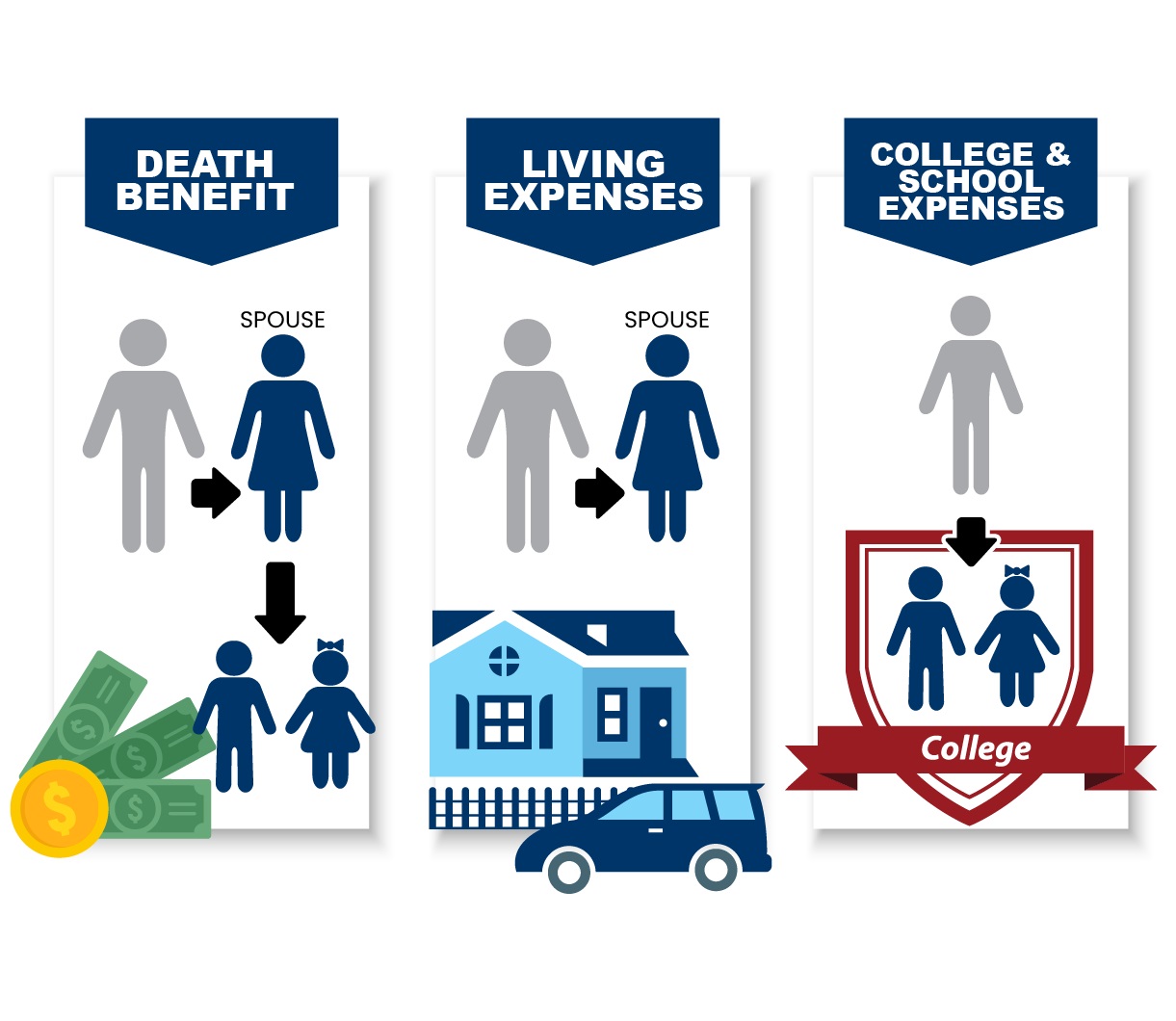Home>Finance>What Happens To Life Insurance When You Divorce?


Finance
What Happens To Life Insurance When You Divorce?
Published: October 16, 2023
Discover what happens to life insurance policies during a divorce and how it impacts your financial future. Ensure your finances stay secure with expert advice on handling life insurance after a divorce.
(Many of the links in this article redirect to a specific reviewed product. Your purchase of these products through affiliate links helps to generate commission for LiveWell, at no extra cost. Learn more)
Table of Contents
- Introduction
- Understanding Life Insurance in Divorce
- Joint Life Insurance Policies
- Nominating Beneficiaries
- Dividing Life Insurance as Marital Property
- Life Insurance and Spousal Support/Alimony
- Life Insurance and Child Support
- Modifying Life Insurance Policies after Divorce
- Canceling or Changing Life Insurance Policies
- Conclusion
Introduction
Divorce can be a complex and emotionally challenging process, involving the division of assets, financial support arrangements, and the restructuring of lives. Among the important considerations during divorce is the fate of life insurance policies, which often play a crucial role in providing financial security for families.
Life insurance is a financial tool designed to provide a sum of money, known as a death benefit, to designated beneficiaries upon the policyholder’s death. It serves as a way to offer protection and support for loved ones who may be dependent on the deceased’s income.
When it comes to divorce, life insurance policies can take on added significance. They may provide a source of income or serve as a way to secure outstanding financial obligations, such as spousal support or child support payments. Understanding what happens to existing life insurance policies when a couple divorces is essential to navigate this process successfully.
In this article, we will explore the implications of divorce on life insurance policies. We will discuss joint life insurance policies, the nomination of beneficiaries, the division of life insurance as marital property, and the roles life insurance plays in spousal and child support arrangements. Additionally, we will delve into the options for modifying or canceling life insurance policies post-divorce.
Divorce can be daunting, but with the right knowledge and planning, individuals can make informed decisions about their life insurance policies. Let’s delve deeper into the specifics of life insurance and divorce to gain a better understanding of this complex area.
Understanding Life Insurance in Divorce
Before delving into the details of how life insurance is affected by divorce, it’s important to have a basic understanding of how life insurance works.
Life insurance policies are typically categorized into two main types: term life insurance and permanent life insurance. Term life insurance provides coverage for a specified period, whereas permanent life insurance offers lifelong coverage with a cash value component.
During a divorce, life insurance policies can serve various purposes. They may be used to secure financial support obligations, provide for the preservation of assets, or protect dependent children and other beneficiaries.
In many cases, one or both spouses may have existing life insurance policies. These policies may have been acquired individually or jointly during the course of the marriage. Understanding the nature and terms of these policies is crucial to determine their role in the divorce settlement.
It’s important to note that life insurance policies are considered personal property and may be subject to the laws governing the division of assets during divorce. The extent to which a life insurance policy is considered marital property depends on various factors, including when it was acquired, how premiums were paid, and whether it was acquired jointly or individually.
It’s recommended that individuals consult with a divorce attorney or financial advisor who can provide personalized guidance on the specific implications of life insurance in their divorce. These professionals can help answer questions and ensure the proper steps are taken to protect all parties involved.
Joint Life Insurance Policies
One common scenario in divorce involves joint life insurance policies. A joint life insurance policy is a single policy that covers two individuals, typically a married couple. The death benefit is paid out upon the first death, providing financial security for the surviving spouse or other designated beneficiaries.
In the case of divorce, the fate of a joint life insurance policy will depend on the agreement reached between the divorcing parties. There are generally three options:
- Maintaining the policy: Sometimes, divorcing couples may choose to continue the joint life insurance policy even after the divorce. This option is typically taken when there are ongoing financial obligations or dependent children involved. However, it’s important to review the policy’s terms and consult with an attorney to ensure the policy aligns with the post-divorce arrangement.
- Transferring ownership: In certain cases, divorcing couples may decide to transfer the ownership of the joint life insurance policy to one of the spouses. This transfer may be part of the divorce settlement and can help facilitate the division of assets. It’s crucial to update the beneficiaries accordingly to reflect the new ownership.
- Cancelling or converting the policy: If both spouses agree and there are no ongoing financial obligations or dependents involved, the joint life insurance policy may be canceled altogether. Alternatively, one party may choose to convert the joint policy into an individual policy to maintain coverage.
Reaching a mutual agreement about joint life insurance policies can be complex and may require negotiation and legal advice. It’s important to carefully consider the financial implications of each option and the long-term needs of both parties.
Additionally, it’s crucial to check the policy terms and conditions, as some joint life insurance policies may have stipulations about what happens in the event of divorce. Understanding these provisions can help inform the decision-making process.
Working with a divorce attorney or financial advisor can provide valuable guidance in navigating the complexities of joint life insurance policies during divorce. Their expertise can help ensure that both parties’ interests are protected and that the chosen course of action aligns with individual circumstances.
Nominating Beneficiaries
Choosing beneficiaries is a fundamental aspect of life insurance. During a divorce, it’s important to review and revise the beneficiaries listed on existing life insurance policies to reflect the changing circumstances.
In most cases, married couples name each other as the primary beneficiaries on their life insurance policies. However, during divorce, individuals may wish to update the beneficiary designation to reflect their new preferences. Failure to do so can lead to unintended consequences and conflicts down the line.
Here are some considerations regarding nominating beneficiaries during and after divorce:
- Reviewing existing policies: It’s essential to review all existing life insurance policies and understand the beneficiary designations. This includes policies held individually, jointly, or through employment benefits. Make a list of all policies and identify any updates that need to be made.
- Updating beneficiaries: Speak with the insurance company or your insurance agent to update the beneficiaries on the policies. It’s common for individuals to change the beneficiaries to their children or other dependents after divorce. Depending on the divorce settlement, it may also be necessary to update beneficiary designations for any policies transferred to an ex-spouse.
- Consider legal obligations: In some cases, divorce settlements may include specific instructions regarding life insurance beneficiaries. For example, a court may require a specific person, such as an ex-spouse or children, to be named as a beneficiary to secure ongoing spousal or child support payments. It’s important to follow these instructions to avoid legal consequences.
- Update contingent beneficiaries: In addition to updating primary beneficiaries, consider updating contingent beneficiaries as well. Contingent beneficiaries are individuals who would receive the death benefit if the primary beneficiary predeceases the insured. Make sure to review and update the contingent beneficiaries to align with your current wishes.
- Communicate with the beneficiaries: After updating the beneficiaries on your life insurance policies, consider informing the relevant individuals about their designation. Open communication can help prevent misunderstandings and ensure that everyone is aware of their potential entitlements upon your passing.
Remember, this is a critical step in the divorce process, and it’s essential to consult with a divorce attorney or financial advisor to ensure that all necessary updates are made correctly and in compliance with the relevant legal requirements.
Dividing Life Insurance as Marital Property
During a divorce, all marital assets are subject to division between the spouses. This includes life insurance policies, which are considered marital property if acquired during the course of the marriage. However, the division of life insurance as marital property can be a complex process and may vary depending on the jurisdiction and specific circumstances of the divorce.
Here are some key considerations when it comes to dividing life insurance as marital property:
- Evaluating the value: Determining the value of a life insurance policy can be challenging, as it often involves analyzing the policy’s death benefit, cash value (in the case of permanent life insurance), and the premiums paid. It may require the assistance of an actuary or financial expert to accurately assess the policy’s value.
- Considering contributions: If both spouses have contributed to the life insurance policy during the marriage, such as paying premiums or maintaining the policy, the value of those contributions may be taken into account during the division process. The contributions made by each spouse will be considered when determining how the policy should be divided.
- Negotiating a settlement: In some cases, divorcing spouses may negotiate a settlement that addresses the division of life insurance policies. This can involve different options, such as one party buying out the other’s interest in the policy or agreeing to maintain the policy for the benefit of a specific beneficiary, such as a child or a dependent spouse.
- Court involvement: If the divorcing parties cannot reach an agreement on the division of life insurance, the court may step in to make a determination. The court will consider various factors, including the financial circumstances of each party, their respective contributions to the policy, and the best interests of any dependents named as beneficiaries.
- Updating ownership and beneficiaries: Once the division of life insurance policies has been determined, it’s essential to update the ownership and beneficiary designations accordingly. This ensures that the appropriate parties receive the intended benefits and that ownership reflects the new agreement.
It’s crucial to consult with a divorce attorney or financial advisor who specializes in family law to navigate the division of life insurance as marital property. They can provide guidance based on the specific laws and regulations in your jurisdiction and help secure a fair and equitable outcome.
Life Insurance and Spousal Support/Alimony
Life insurance can play a significant role in securing spousal support or alimony payments in the event of the paying spouse’s death. It provides a financial safety net for the recipient spouse, ensuring that the agreed-upon support payments continue even if the paying spouse passes away.
When spousal support or alimony is part of a divorce settlement, the court may require the paying spouse to obtain a life insurance policy with the recipient spouse named as the beneficiary. This policy acts as security, guaranteeing that the support payments will be fulfilled in case of the payer’s death.
The specific details of life insurance requirements for spousal support or alimony can vary depending on jurisdiction and individual circumstances. Here are some key points to understand:
- Policy coverage amount: The court may specify a minimum coverage amount that the paying spouse must have, reflecting the agreed-upon support payments. This ensures that there are sufficient funds to continue supporting the recipient spouse in the event of the paying spouse’s death.
- Policy duration: The court may also determine the length of time the life insurance policy must remain in effect. This duration typically corresponds to the length of the spousal support or alimony obligation. Once the obligation ends, the paying spouse may be released from the requirement to maintain the policy.
- Cost and payment responsibility: The paying spouse is generally responsible for the cost of the life insurance policy premiums. However, depending on the specific terms of the divorce settlement, the paying spouse may be able to include the cost of premiums as part of the support payment agreement.
- Policy ownership: In cases where the paying spouse is required to maintain a life insurance policy for spousal support or alimony, they are typically the owner of the policy and have control over its terms and beneficiaries. It’s crucial to update the beneficiary designation to reflect the recipient spouse’s status, as specified in the court order.
- Changing the policy: If there are changes in the spousal support or alimony agreement, such as a modification in the amount or duration, it may be necessary to adjust the coverage and terms of the life insurance policy accordingly. This ensures that the policy aligns with the updated obligations.
It’s important to consult with a divorce attorney or financial advisor to understand the specific requirements related to life insurance and spousal support or alimony in your jurisdiction. They can guide you through the process and ensure that the necessary policies are in place to provide financial security for the recipient spouse.
Life Insurance and Child Support
When child support is part of a divorce settlement or custody agreement, life insurance can provide essential protection for the financial well-being of the children involved. It ensures that support payments continue in the event of the paying parent’s death, providing security and stability for the children’s future.
In many cases, a court may require the paying parent to obtain a life insurance policy with the children named as beneficiaries. This policy acts as a safeguard, ensuring that financial support will be available to meet the children’s ongoing needs even if the paying parent passes away.
Here are some key points to understand regarding life insurance and child support:
- Policy coverage amount: The court may stipulate a minimum coverage amount for the life insurance policy based on the expected child support payments. This amount is typically determined by considering the children’s current and future financial needs, such as education, healthcare, and general support.
- Policy duration: The court will determine the duration of the required life insurance policy, generally aligning with the period of child support obligations. This ensures that the policy remains in effect for as long as the children are entitled to receive support.
- Ownership and cost: The paying parent is typically responsible for the cost of the life insurance premiums. They are also the owner of the policy and have control over its terms and beneficiaries. It’s important to update the beneficiary designations to include the children as specified in the court order.
- Changing the policy: If there are changes in the child support agreement, such as modifications in the amount or duration of support, it may be necessary to adjust the coverage and terms of the life insurance policy to reflect these changes accurately.
- Considerations for blended families: In cases where there are children from previous relationships or blended families, the life insurance policy may need to consider the needs of all children involved. This may require discussions and agreements around how the death benefit will be divided among the different beneficiaries.
It’s essential to consult with a divorce attorney or financial advisor who specializes in family law to understand the specific requirements related to life insurance and child support in your jurisdiction. They can guide you through the process, ensuring that the necessary policies are in place to protect the financial well-being of the children.
Modifying Life Insurance Policies after Divorce
After a divorce, it’s often necessary to make modifications to existing life insurance policies to reflect the new circumstances and ensure the policies align with the post-divorce arrangements. Modifying life insurance policies after divorce may involve updating ownership, changing beneficiaries, or adjusting coverage and terms. Here are some key considerations:
- Reviewing existing policies: Start by reviewing all existing life insurance policies held individually, jointly, or through employment benefits. Understand the terms, coverage, and beneficiaries listed on each policy.
- Updating ownership: If the divorce settlement involves transferring ownership of a life insurance policy, complete the necessary paperwork to reflect the new owner. Consult with the insurance company or an attorney to ensure the proper documentation is submitted.
- Updating beneficiaries: After a divorce, individuals may want to change the beneficiaries on their life insurance policies. This could involve removing an ex-spouse as a beneficiary, adding children as beneficiaries, or designating new individuals as beneficiaries based on the post-divorce agreements.
- Adjusting coverage and terms: Assess the coverage amount and policy terms to ensure they align with the new financial circumstances and responsibilities. Consider any ongoing support obligations, such as child support or spousal support, and adjust the coverage accordingly.
- Reassessing financial needs: After a divorce, it’s important to reassess financial needs and goals. This includes evaluating the purpose of existing life insurance policies and whether they still serve the intended objectives. Consider consulting with a financial advisor to determine the most appropriate coverage amount and policy type.
- Considering new policies: In some cases, it may be necessary to acquire new life insurance policies post-divorce to fulfill obligations or meet new financial needs. This could involve obtaining separate policies for child support or spousal support purposes or addressing other specific financial requirements.
- Updating other insurance policies: In addition to life insurance, consider reviewing and updating other insurance policies, such as health insurance, disability insurance, or long-term care insurance, to ensure they align with the post-divorce situation.
It’s essential to consult with a divorce attorney or financial advisor who can provide guidance specific to your situation when modifying life insurance policies after a divorce. They can help navigate the process, ensure compliance with legal requirements, and help you make informed decisions about your insurance needs.
Canceling or Changing Life Insurance Policies
After a divorce, it may be necessary to cancel or change existing life insurance policies to reflect the new circumstances and financial needs. This could involve terminating a policy, converting a policy, or acquiring new coverage. Here are some important considerations:
- Evaluating the need for coverage: Assess whether the existing life insurance policies continue to serve a meaningful purpose post-divorce. Consider your financial obligations, support agreements, and any dependents who rely on the coverage. Determine if maintaining the policies is still necessary or if cancellation or modification is appropriate.
- Canceling a policy: If the existing life insurance policies are no longer needed or do not align with the new situation, consider canceling them. Contact the insurance company to inquire about the cancellation process and any associated fees or surrender charges. Keep in mind that canceling a policy means forfeiting the future death benefit, so carefully evaluate the consequences before making a decision.
- Converting a policy: In some cases, it may be beneficial to convert an existing life insurance policy to a new type of policy or change the coverage amount. This could involve converting a term life insurance policy to a permanent policy or adjusting the coverage to better meet your current needs.
- Acquiring new coverage: If the existing life insurance policies are insufficient or no longer applicable, consider acquiring new coverage tailored to your post-divorce circumstances. Seek guidance from a financial advisor or insurance professional to ensure you obtain the most suitable policy with the appropriate coverage amount and terms.
- Updating policy ownership and beneficiaries: If you decide to keep or acquire new life insurance policies, ensure that the ownership and beneficiary designations reflect the new situation. Update the policies to align with the divorce settlement, including removing an ex-spouse as a beneficiary and designating new beneficiaries as needed.
- Understanding the implications: It’s important to comprehend the potential consequences of canceling or modifying life insurance policies. Consider any legal and financial obligations related to support payments, existing court orders, or divorce settlements. Consult with a divorce attorney or financial advisor to fully understand the impact before making any changes.
- Communication and documentation: Throughout the process of canceling or changing life insurance policies, maintain proper communication and documentation. Keep records of conversations with insurance providers, update beneficiaries, and inform relevant parties about any modifications or new policies acquired.
Make sure to consult with a divorce attorney, financial advisor, or insurance professional who can provide personalized guidance tailored to your specific circumstances. They can help navigate the process, ensure compliance with legal requirements, and assist in making informed decisions regarding your life insurance coverage.
Conclusion
Divorce is a complex process that carries significant financial implications, including the fate of life insurance policies. Understanding how life insurance is affected by divorce is crucial to navigate the post-divorce landscape while ensuring financial security for both parties and any dependents.
Throughout the divorce process, it is essential to review existing life insurance policies, update beneficiaries, and consider the role of these policies in relation to spousal support, child support, and the division of marital property. Joint life insurance policies may need to be maintained, transferred, or canceled based on the specific circumstances and agreements reached.
Nominating beneficiaries is a critical step in adjusting life insurance policies post-divorce. Ensuring that the correct individuals are designated as beneficiaries is key to protecting the intended recipients and avoiding conflicts in the future.
Dividing life insurance as marital property requires careful evaluation of the policy’s value, contributions made by both parties, and negotiations or court involvement for a fair and equitable outcome.
Life insurance can also play a vital role in securing spousal support and child support payments. The court may often require the paying spouse to maintain a policy that covers the support obligations, providing financial protection for the receiving spouse and children in the event of the paying spouse’s death.
Modifying or canceling life insurance policies after divorce is an important step in aligning them with the new financial circumstances. Careful consideration should be given to coverage amounts, beneficiaries, and the need for new policies to meet individual needs and obligations.
In conclusion, navigating life insurance in the context of divorce requires a thorough understanding of the policies, legal obligations, and financial considerations. Seeking guidance from professionals, such as divorce attorneys and financial advisors, is essential to ensure the proper steps are taken to protect all parties involved and secure a stable financial future after divorce.














